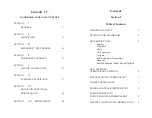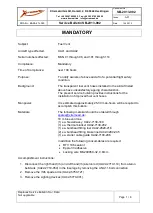
4
Construction
Trim
Safety equipment
The EDEN 3 is a second rib diagonal-construction paraglider. Every second main rib is
attached to the lines and other ribs are attached at A, B and C-points thanks to the
diagonal segments. These segments do not lead to top surface of canopy but are
attached at 80% of rib's height. This technique was already used on the EDEN 1 and is
used by many other manufacturers in the industry.
The glider is delivered with a standard set-up and its speed can reach 36 - 38 km/h
depending on the weight of the pilot. The brake-lines should always be adjusted so that
the first brake-lines just come under tension when the brake handles have been pulled
5 - 10 cm.
The test results relate to this brake-line adjustment. In extreme situations other settings
may lead to the glider reacting differently. To be able at all times to react quickly enough
to possible problems; you should not let go of the brake handles during the flight (it may
be possible to hold both handles in one hand). Alter the line length to bring the handles to
a suitable height when using your harness.
An optimal outfit should be a matter of course for every paraglider pilot. Always wear
stout footwear, a helmet, and gloves. Clothing should be warm and allow sufficient
freedom of movement. A rescue-system can be life-saving in case of an irremediable
disturbance of the canopy, collapse in the air or material failure, and is therefore
imperative.
NOTE!!
If in doubt about the brake-line adjustment, it is preferable to leave them too
long, as any necessary shortening can easily be achieved by wrapping them round your
hand.
3
Warning and safety precautions
The buyer of this product accepts full responsibility for all risks associated with
paragliding inclusive of injury and death. Any inadequate use or misuse increases the
risks considerably. The buyer should be aware of the need to complete a paragliding
training course and should be in possession of a valid flying licence as required by the
relevant country.
Any changes made to this paraglider invalidate the certificate of airworthiness.
The EDEN 3 must not be used:
- outside the certified weight range
- during rain or snow-fall
- in high or gusty winds
- in cloud and fog
- by pilots without sufficient knowledge or experience
The EDEN 3 is certified for solo flight.
Operating limits
The EDEN 3 has been developed for foot-launch, and for solo flights.
The EDEN 3 has been tested by DHV test pilots to DHV 1-2 GH category.
The GH stands for 95% of all sitting harnesses in use. It simply means that a harness
with a chest-strap is needed. It also has been load and shock-tested and passed with a
load corresponding to 12 G of the maximum weight in flight 130 kg. DHV requires 8G. Its
flying test have shown that the glider remains stable and controllable over a wide range
of normal and abnormal flight conditions. Nevertheless, turbulence and gusting winds
can lead to a partial or complete collapse of the canopy. Therefore never fly in such
conditions.






























